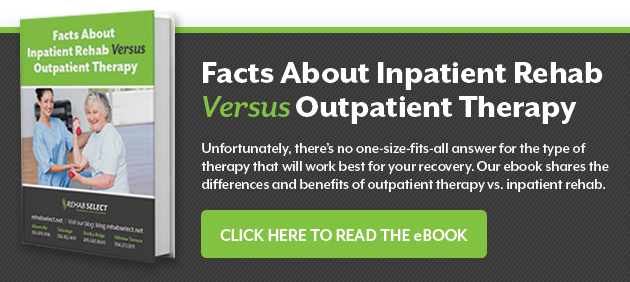 Inpatient rehab physical therapy provides intensive, individualized treatment to improve the strength, endurance, functional ability and well-being of the patients it serves. It can benefit patients of all ages who suffer with a wide range of conditions that cause some level of impairment.
Inpatient rehab physical therapy provides intensive, individualized treatment to improve the strength, endurance, functional ability and well-being of the patients it serves. It can benefit patients of all ages who suffer with a wide range of conditions that cause some level of impairment.
Here is how inpatient rehab physical therapy can help these five conditions:
1. Joint Replacement Recovery
Inpatient rehab physical therapy offers a comprehensive, team-based approach to intensive rehabilitative treatment, which offers a number of advantages to joint replacement patients as compared to less intensive outpatient programs. This approach promotes faster, more complete recoveries, including a higher level of functional improvement and faster and better reduction of pain. Inpatient therapy also reduces risk of post-surgery complications and injuries by offering comprehensive support during the recovery and rehabilitation process.
2. Stroke Recovery
The American Stroke Association, via its Guidelines for Stroke Rehabilitation and Recovery for Adults, recommends inpatient rehab as the best possible environment for stroke recovery. Those recommendations are based on medical research that shows that the intensive, multidisciplinary approach to therapy and care in this environment promotes the best possible level of functional improvement to patients as they recover from the trauma and debility that can result from surviving stroke.
3. COPD Management
Regular exercise can help improve or maintain lung capacity in COPD sufferers, which can aid in slowing the progression of the disease. Inpatient rehab physical therapy can provide a safe, medically supervised environment for patients to gradually increase their exercise tolerance with the help of physical therapy professionals. Additionally, inpatient rehab also educates patients in breathing techniques and exercises that can help reduce the frequency, severity and of incidents of shortness of breath for better day-to-day disease management.
4. Arthritis Management
Inpatient rehab physical therapy has a great deal to offer people who are living with arthritis and are struggling to manage the impact of the disease on their everyday lives. Intensive physical therapy can help improve strength and flexibility in muscles surrounding affected joints, providing those joints better support to reduce daily pain and stiffness and, in many cases, reduce the rate at which damage to the joints progresses. Inpatient rehab also offers comprehensive patient education and occupational therapy that can help in managing the disease more effectively day-to-day.
5. Heart Attack Recovery
Inpatient rehab physical therapy offers a safe, medically supervised environment in which to recover, regain strength, and learn heart-healthy exercise to reduce risk of another cardiac event. Inpatient rehabilitative treatment also offers patient education on lifestyle changes, stress management and other strategies for managing risk factors and improving cardiovascular health.
These five conditions represent just a very small sample of the very long list that inpatient physical therapy can help. The intensive, team-based and patient-centered approach that is the hallmark of good inpatient rehab programs can benefit patients with a wide variety of injuries, degenerative diseases and health conditions, helping them regain functional ability, well-being, independence and quality-of-life as safely, quickly and completely as is possible for each individual patient.





